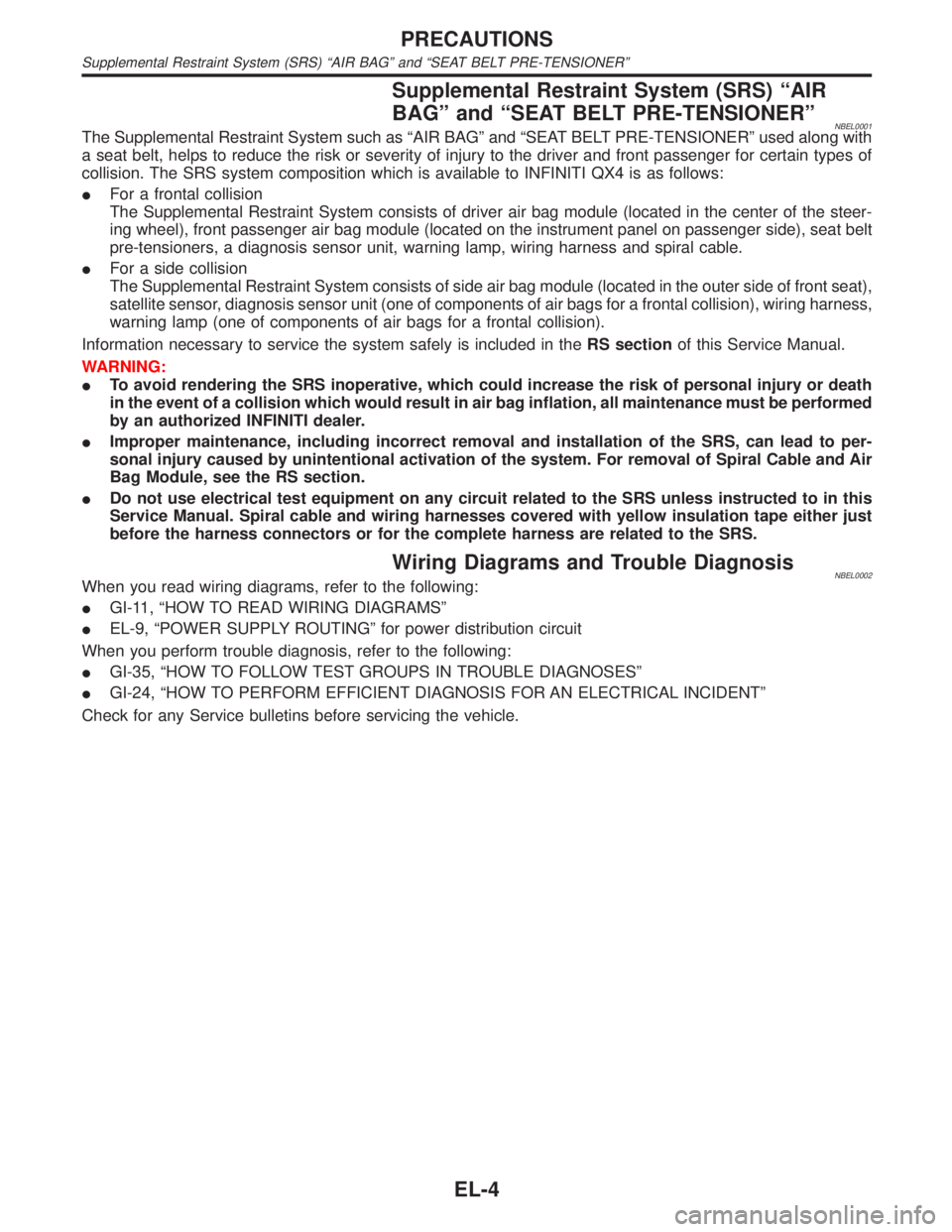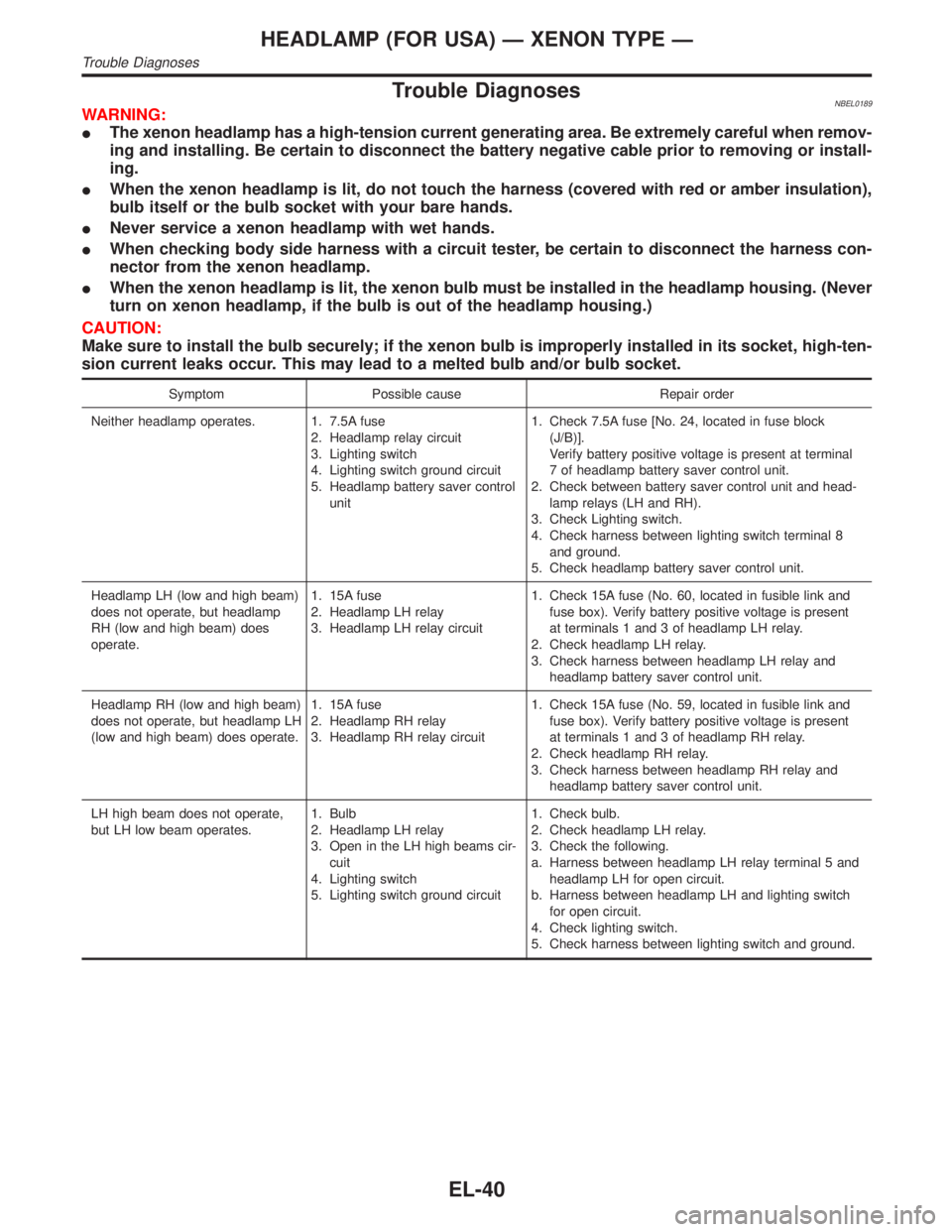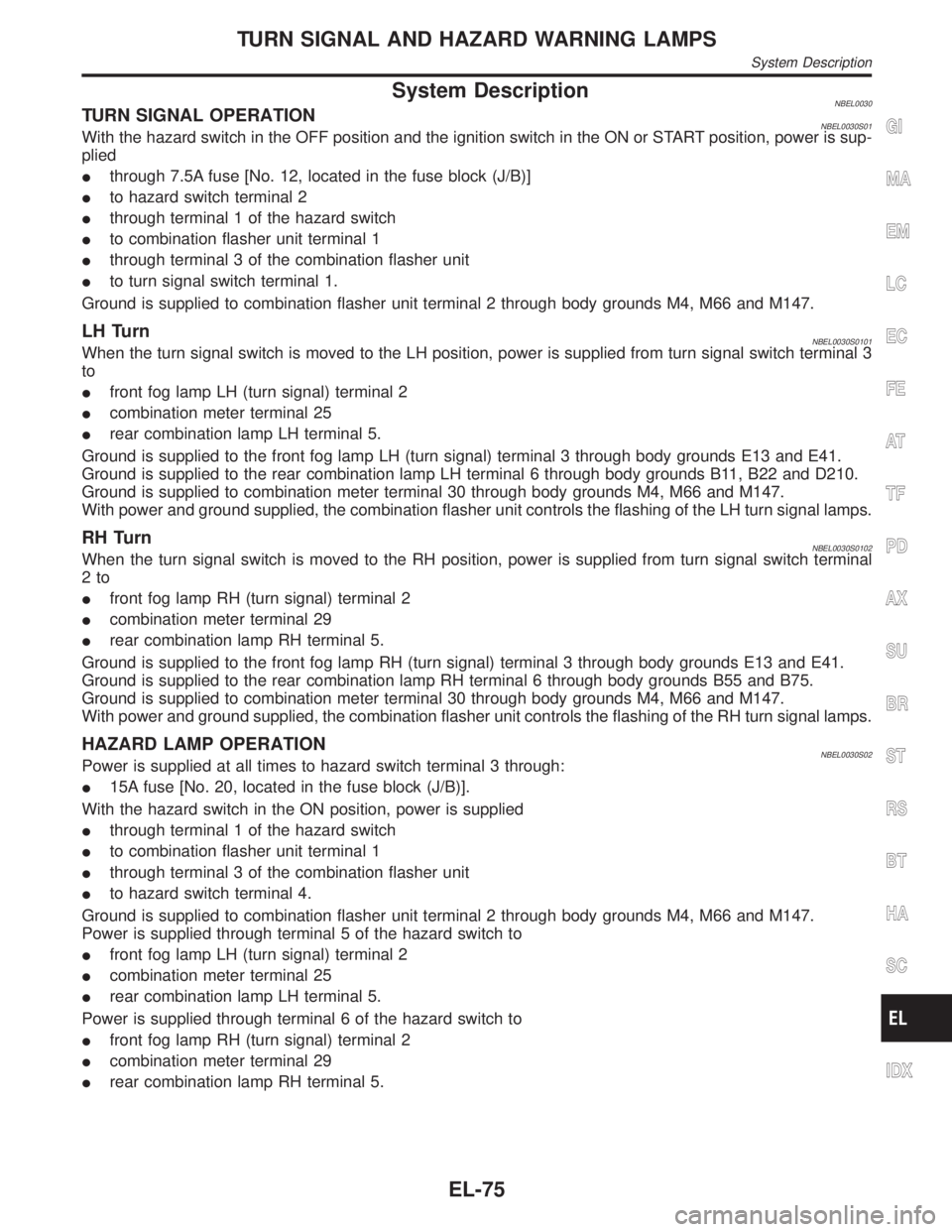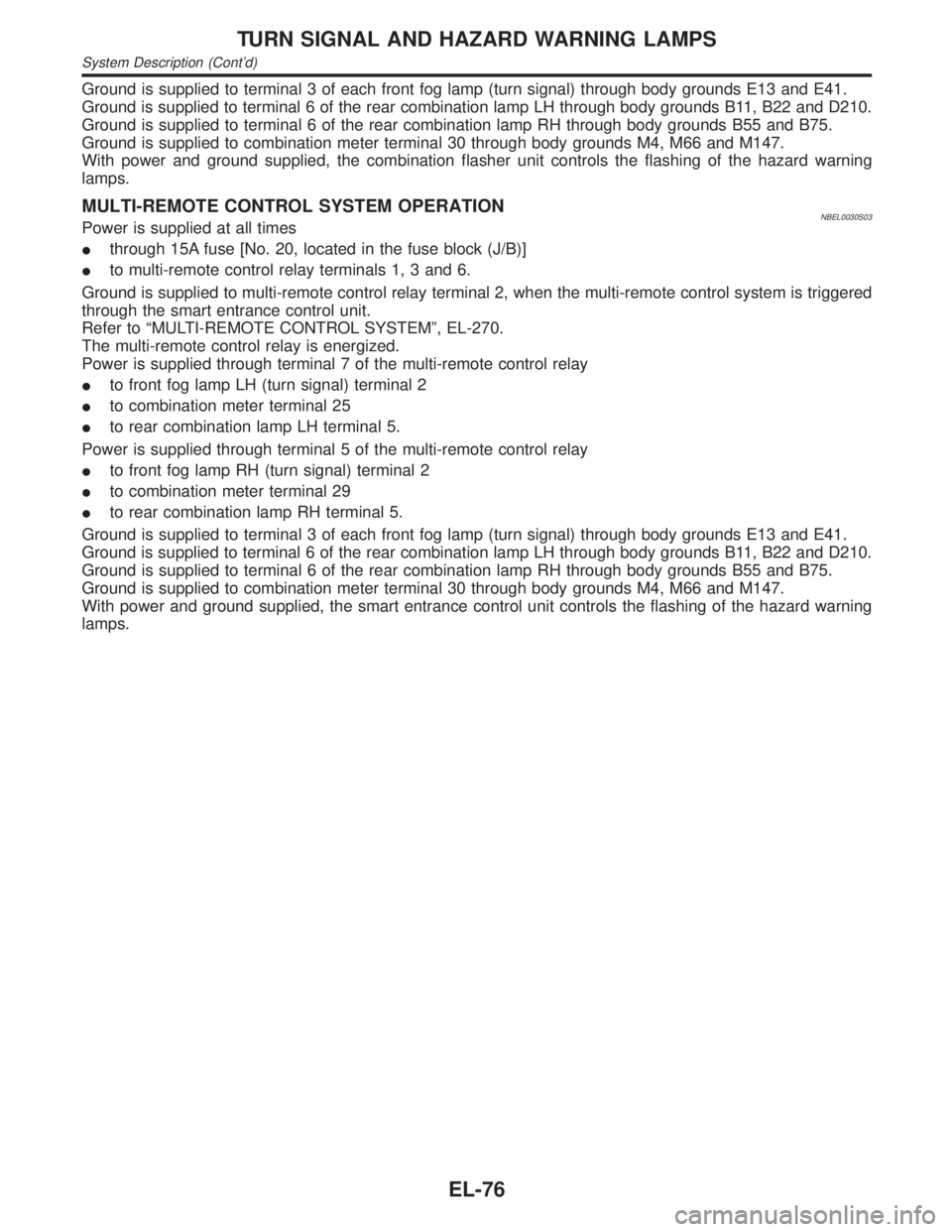2001 INFINITI QX4 warning
[x] Cancel search: warningPage 1189 of 2395

Supplemental Restraint System (SRS) ªAIR
BAGº and ªSEAT BELT PRE-TENSIONERº
NBEL0001The Supplemental Restraint System such as ªAIR BAGº and ªSEAT BELT PRE-TENSIONERº used along with
a seat belt, helps to reduce the risk or severity of injury to the driver and front passenger for certain types of
collision. The SRS system composition which is available to INFINITI QX4 is as follows:
IFor a frontal collision
The Supplemental Restraint System consists of driver air bag module (located in the center of the steer-
ing wheel), front passenger air bag module (located on the instrument panel on passenger side), seat belt
pre-tensioners, a diagnosis sensor unit, warning lamp, wiring harness and spiral cable.
IFor a side collision
The Supplemental Restraint System consists of side air bag module (located in the outer side of front seat),
satellite sensor, diagnosis sensor unit (one of components of air bags for a frontal collision), wiring harness,
warning lamp (one of components of air bags for a frontal collision).
Information necessary to service the system safely is included in theRS sectionof this Service Manual.
WARNING:
ITo avoid rendering the SRS inoperative, which could increase the risk of personal injury or death
in the event of a collision which would result in air bag inflation, all maintenance must be performed
by an authorized INFINITI dealer.
IImproper maintenance, including incorrect removal and installation of the SRS, can lead to per-
sonal injury caused by unintentional activation of the system. For removal of Spiral Cable and Air
Bag Module, see the RS section.
IDo not use electrical test equipment on any circuit related to the SRS unless instructed to in this
Service Manual. Spiral cable and wiring harnesses covered with yellow insulation tape either just
before the harness connectors or for the complete harness are related to the SRS.
Wiring Diagrams and Trouble DiagnosisNBEL0002When you read wiring diagrams, refer to the following:
IGI-11, ªHOW TO READ WIRING DIAGRAMSº
IEL-9, ªPOWER SUPPLY ROUTINGº for power distribution circuit
When you perform trouble diagnosis, refer to the following:
IGI-35, ªHOW TO FOLLOW TEST GROUPS IN TROUBLE DIAGNOSESº
IGI-24, ªHOW TO PERFORM EFFICIENT DIAGNOSIS FOR AN ELECTRICAL INCIDENTº
Check for any Service bulletins before servicing the vehicle.
PRECAUTIONS
Supplemental Restraint System (SRS) ªAIR BAGº and ªSEAT BELT PRE-TENSIONERº
EL-4
Page 1218 of 2395

Ito headlamp battery saver control unit terminals 5 and 13 from lighting switch terminal 11, and
Ito headlamp LH and RH relays terminal 2 from headlamp battery saver control unit terminals 2 and 8
Ithrough headlamp battery saver control unit terminals 3 and 9, and
Ithrough lighting switch terminal 12.
Then headlamps illuminate again.
AUTO LIGHT OPERATIONNBEL0188S05When lighting switch is in ªAUTOº position, ground is supplied
Ito auto light control unit terminal 10
Ifrom lighting switch terminal 42.
When ignition switch is turn to ªONº or ªSTARTº position and outside brightness is darker than prescribed level.
Ground is supplied
Ito headlamp relay LH and RH terminals 2
Ithrough battery saver control unit
Ifrom auto light control unit terminal 6, and
Ito tail lamp relay terminal 1
Ithrough battery saver control unit
Ifrom auto light control unit terminal 7.
Then both headlamp relays and tail lamp relay are energized, headlamps (low or high) and tail lamps are illu-
minate according to switch position.
Auto light operation allows headlamps and tail lamps to go off when
IIgnition switch is turned to ªOFFº position or
IOutside brightness is brighter than prescribed level.
NOTE:
The delay time is varies up to maximum of 20 seconds as the outside brightness changes.
For parking, license and tail lamp auto operation, refer to ªPARKING, LICENSE AND TAIL LAMPSº.
THEFT WARNING SYSTEMNBEL0188S06The theft warning system will flash the low beams if the system is triggered. Refer to ªTHEFT WARNING
SYSTEMº (EL-296).
GI
MA
EM
LC
EC
FE
AT
TF
PD
AX
SU
BR
ST
RS
BT
HA
SC
IDX
HEADLAMP (FOR USA) Ð XENON TYPE Ð
System Description (Cont'd)
EL-33
Page 1225 of 2395

Trouble DiagnosesNBEL0189WARNING:
IThe xenon headlamp has a high-tension current generating area. Be extremely careful when remov-
ing and installing. Be certain to disconnect the battery negative cable prior to removing or install-
ing.
IWhen the xenon headlamp is lit, do not touch the harness (covered with red or amber insulation),
bulb itself or the bulb socket with your bare hands.
INever service a xenon headlamp with wet hands.
IWhen checking body side harness with a circuit tester, be certain to disconnect the harness con-
nector from the xenon headlamp.
IWhen the xenon headlamp is lit, the xenon bulb must be installed in the headlamp housing. (Never
turn on xenon headlamp, if the bulb is out of the headlamp housing.)
CAUTION:
Make sure to install the bulb securely; if the xenon bulb is improperly installed in its socket, high-ten-
sion current leaks occur. This may lead to a melted bulb and/or bulb socket.
Symptom Possible cause Repair order
Neither headlamp operates. 1. 7.5A fuse
2. Headlamp relay circuit
3. Lighting switch
4. Lighting switch ground circuit
5. Headlamp battery saver control
unit1. Check 7.5A fuse [No. 24, located in fuse block
(J/B)].
Verify battery positive voltage is present at terminal
7 of headlamp battery saver control unit.
2. Check between battery saver control unit and head-
lamp relays (LH and RH).
3. Check Lighting switch.
4. Check harness between lighting switch terminal 8
and ground.
5. Check headlamp battery saver control unit.
Headlamp LH (low and high beam)
does not operate, but headlamp
RH (low and high beam) does
operate.1. 15A fuse
2. Headlamp LH relay
3. Headlamp LH relay circuit1. Check 15A fuse (No. 60, located in fusible link and
fuse box). Verify battery positive voltage is present
at terminals 1 and 3 of headlamp LH relay.
2. Check headlamp LH relay.
3. Check harness between headlamp LH relay and
headlamp battery saver control unit.
Headlamp RH (low and high beam)
does not operate, but headlamp LH
(low and high beam) does operate.1. 15A fuse
2. Headlamp RH relay
3. Headlamp RH relay circuit1. Check 15A fuse (No. 59, located in fusible link and
fuse box). Verify battery positive voltage is present
at terminals 1 and 3 of headlamp RH relay.
2. Check headlamp RH relay.
3. Check harness between headlamp RH relay and
headlamp battery saver control unit.
LH high beam does not operate,
but LH low beam operates.1. Bulb
2. Headlamp LH relay
3. Open in the LH high beams cir-
cuit
4. Lighting switch
5. Lighting switch ground circuit1. Check bulb.
2. Check headlamp LH relay.
3. Check the following.
a. Harness between headlamp LH relay terminal 5 and
headlamp LH for open circuit.
b. Harness between headlamp LH and lighting switch
for open circuit.
4. Check lighting switch.
5. Check harness between lighting switch and ground.
HEADLAMP (FOR USA) Ð XENON TYPE Ð
Trouble Diagnoses
EL-40
Page 1228 of 2395

Terminal No.Wire
colorItem ConditionVoltage
(Approximate value)
10 R/Y RAP signal Ignition switch OFF or ACC
(After more than 45 seconds with ignition
switch turned OFF or ACC)Less than 1V
ON or START Battery voltage
11 B Ground Ð Ð
13 G Tail lamp switch Lighting switch OFF Battery voltage
1ST or 2ND Less than 1V
14 R Tail lamp relay Ignition switch
(with lighting switch
1ST or 2ND)OFF or ACC More than 45 sec-
onds after ignition
switch is turned
OFF or ACCBattery voltage
Within 45 seconds
after ignition switch
is turned OFF or
ACCLess than 1V
ON or START Less than 1V
Headlamps illuminate by auto light control. Less than 1V
Bulb Replacement/Xenon TypeNBEL0190CAUTION:
IAfter replacing a new xenon bulb, be sure to make aiming
adjustments.
IHold only the plastic base when handling the bulb. Never
touch the glass envelope.
IDo not leave headlamp reflector without bulb for a long
period of time. Dust, moisture, smoke, etc. entering head-
lamp body may affect the performance of the headlamp.
Remove headlamp bulb from the headlamp reflector just
before a replacement bulb is installed.
1. Disconnect negative battery cable.
2. Disconnect headlamp connector.
3. Remove headlamp assembly.
WARNING:
Never service a xenon headlamp without disconnecting nega-
tive battery cable and with wet hands.
SEL349X
XENON BULB (LOW BEAM)NBEL0190S011. Remove headlamp seal cover.
GI
MA
EM
LC
EC
FE
AT
TF
PD
AX
SU
BR
ST
RS
BT
HA
SC
IDX
HEADLAMP (FOR USA) Ð XENON TYPE Ð
Trouble Diagnoses (Cont'd)
EL-43
Page 1260 of 2395

System DescriptionNBEL0030TURN SIGNAL OPERATIONNBEL0030S01With the hazard switch in the OFF position and the ignition switch in the ON or START position, power is sup-
plied
Ithrough 7.5A fuse [No. 12, located in the fuse block (J/B)]
Ito hazard switch terminal 2
Ithrough terminal 1 of the hazard switch
Ito combination flasher unit terminal 1
Ithrough terminal 3 of the combination flasher unit
Ito turn signal switch terminal 1.
Ground is supplied to combination flasher unit terminal 2 through body grounds M4, M66 and M147.
LH TurnNBEL0030S0101When the turn signal switch is moved to the LH position, power is supplied from turn signal switch terminal 3
to
Ifront fog lamp LH (turn signal) terminal 2
Icombination meter terminal 25
Irear combination lamp LH terminal 5.
Ground is supplied to the front fog lamp LH (turn signal) terminal 3 through body grounds E13 and E41.
Ground is supplied to the rear combination lamp LH terminal 6 through body grounds B11, B22 and D210.
Ground is supplied to combination meter terminal 30 through body grounds M4, M66 and M147.
With power and ground supplied, the combination flasher unit controls the flashing of the LH turn signal lamps.
RH TurnNBEL0030S0102When the turn signal switch is moved to the RH position, power is supplied from turn signal switch terminal
2to
Ifront fog lamp RH (turn signal) terminal 2
Icombination meter terminal 29
Irear combination lamp RH terminal 5.
Ground is supplied to the front fog lamp RH (turn signal) terminal 3 through body grounds E13 and E41.
Ground is supplied to the rear combination lamp RH terminal 6 through body grounds B55 and B75.
Ground is supplied to combination meter terminal 30 through body grounds M4, M66 and M147.
With power and ground supplied, the combination flasher unit controls the flashing of the RH turn signal lamps.
HAZARD LAMP OPERATIONNBEL0030S02Power is supplied at all times to hazard switch terminal 3 through:
I15A fuse [No. 20, located in the fuse block (J/B)].
With the hazard switch in the ON position, power is supplied
Ithrough terminal 1 of the hazard switch
Ito combination flasher unit terminal 1
Ithrough terminal 3 of the combination flasher unit
Ito hazard switch terminal 4.
Ground is supplied to combination flasher unit terminal 2 through body grounds M4, M66 and M147.
Power is supplied through terminal 5 of the hazard switch to
Ifront fog lamp LH (turn signal) terminal 2
Icombination meter terminal 25
Irear combination lamp LH terminal 5.
Power is supplied through terminal 6 of the hazard switch to
Ifront fog lamp RH (turn signal) terminal 2
Icombination meter terminal 29
Irear combination lamp RH terminal 5.
GI
MA
EM
LC
EC
FE
AT
TF
PD
AX
SU
BR
ST
RS
BT
HA
SC
IDX
TURN SIGNAL AND HAZARD WARNING LAMPS
System Description
EL-75
Page 1261 of 2395

Ground is supplied to terminal 3 of each front fog lamp (turn signal) through body grounds E13 and E41.
Ground is supplied to terminal 6 of the rear combination lamp LH through body grounds B11, B22 and D210.
Ground is supplied to terminal 6 of the rear combination lamp RH through body grounds B55 and B75.
Ground is supplied to combination meter terminal 30 through body grounds M4, M66 and M147.
With power and ground supplied, the combination flasher unit controls the flashing of the hazard warning
lamps.
MULTI-REMOTE CONTROL SYSTEM OPERATIONNBEL0030S03Power is supplied at all times
Ithrough 15A fuse [No. 20, located in the fuse block (J/B)]
Ito multi-remote control relay terminals 1, 3 and 6.
Ground is supplied to multi-remote control relay terminal 2, when the multi-remote control system is triggered
through the smart entrance control unit.
Refer to ªMULTI-REMOTE CONTROL SYSTEMº, EL-270.
The multi-remote control relay is energized.
Power is supplied through terminal 7 of the multi-remote control relay
Ito front fog lamp LH (turn signal) terminal 2
Ito combination meter terminal 25
Ito rear combination lamp LH terminal 5.
Power is supplied through terminal 5 of the multi-remote control relay
Ito front fog lamp RH (turn signal) terminal 2
Ito combination meter terminal 29
Ito rear combination lamp RH terminal 5.
Ground is supplied to terminal 3 of each front fog lamp (turn signal) through body grounds E13 and E41.
Ground is supplied to terminal 6 of the rear combination lamp LH through body grounds B11, B22 and D210.
Ground is supplied to terminal 6 of the rear combination lamp RH through body grounds B55 and B75.
Ground is supplied to combination meter terminal 30 through body grounds M4, M66 and M147.
With power and ground supplied, the smart entrance control unit controls the flashing of the hazard warning
lamps.
TURN SIGNAL AND HAZARD WARNING LAMPS
System Description (Cont'd)
EL-76
Page 1262 of 2395

Wiring Diagram Ð TURN ÐNBEL0032
MEL781L
GI
MA
EM
LC
EC
FE
AT
TF
PD
AX
SU
BR
ST
RS
BT
HA
SC
IDX
TURN SIGNAL AND HAZARD WARNING LAMPS
Wiring Diagram Ð TURN Ð
EL-77
Page 1263 of 2395

MEL782L
TURN SIGNAL AND HAZARD WARNING LAMPS
Wiring Diagram Ð TURN Ð (Cont'd)
EL-78